What is celery: overview, rules of use and growing technology
Celery is a product with a rich chemical composition and negative calorie content. The roots, greens and petioles are used for fresh consumption and preparation of first and second courses. The plant has a lot of useful properties, has a beneficial effect on women's and men's health, normalizes the condition of gout, rheumatism, and urolithiasis.
The culture is unpretentious in care, however, to obtain a rich harvest, it is recommended to adhere to the rules of agricultural technology. In this article we will tell you everything about celery: what it looks like, where and how it grows, how it is used in cooking and folk medicine.
What is celery
What is celery - a vegetable or a herb? This is a vegetable crop in which all parts are edible - roots, leaves and stems.
Celery is a biennial plant from the Apiaceae or Celery family. The birthplace of culture is the Mediterranean countries. The ancient Egyptians and Greeks used it to treat pathologies of internal organs. Where does the culture grow? Celery grows best in temperate climates, in moist, nitrogen-rich soils. The plant is characterized by resistance to minor frosts and ease of care.
There are three types of culture: root, petiolate (stem) and leaf celery. Let's talk about each of them in more detail.
Root
Root celery in the first year of vegetation forms a root crop of gray-white color, round shape, weighing about 500 g, with a diameter of 5-12 cm. The pulp is white or cream. The leaves are three-lobed.The stems reach 0.5 m in height.
The growing season is 180-200 days. In the second year, the plant produces a meter-long flower stem with inflorescences containing brown-gray seeds. The thin skin is cut off before cooking.
The photo shows how the plant blooms.
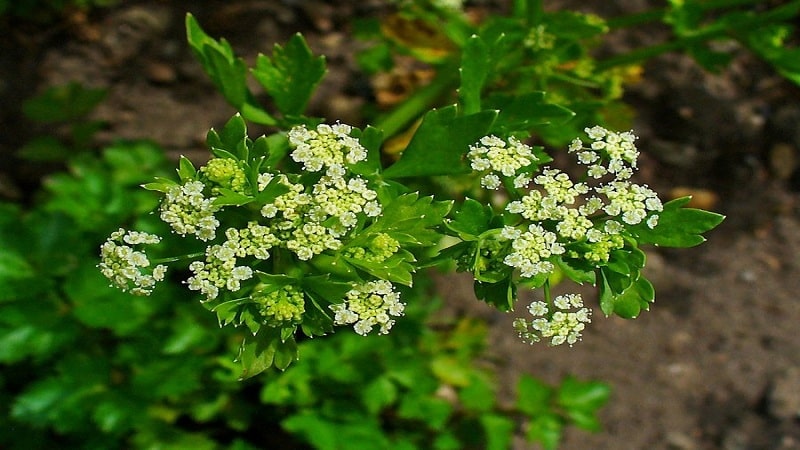
Stem
Stem celery is a biennial plant prized for its juicy, thick stalks that are green, white, pink or red. Self-bleaching varieties are most valued - the stems have a sweet taste without bitterness. Celery with red petioles is frost-resistant down to –5°C and is harvested before the end of October.
In the first year of growth, thick petioles up to 1 m high and green mass are formed. In the second year, a peduncle with seeds appears. The growing season is 80-180 days depending on the variety.
The photo shows petiole celery.
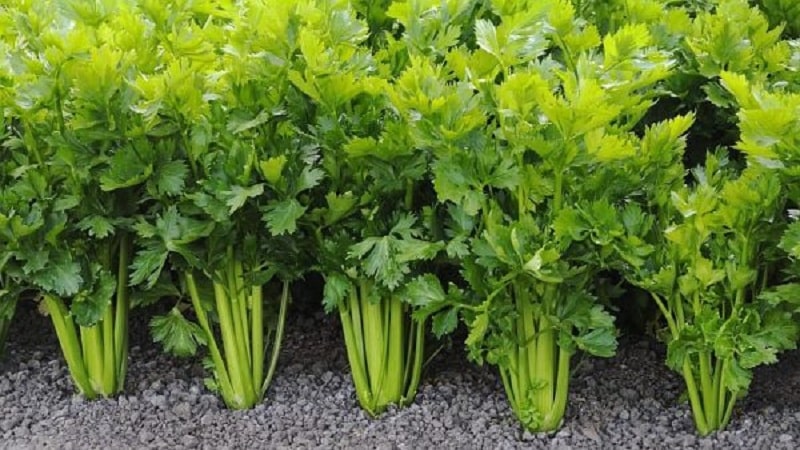
Sheet
Leaf celery is a biennial plant. In the first year, a rosette of dark green leaves is formed. In the second year, a stem 0.3-1 m high and an inflorescence appear. In the second half of July, the plant enters the flowering phase, and in early August the seeds ripen. After this, the plant dies.
The leaf variety does not form thick stems and large roots. Greens are used fresh - put in salads, first and second courses. The wavy leaves resemble parsley, but have a different, distinct aroma and flavor.
The photo shows a leafy variety of the plant.
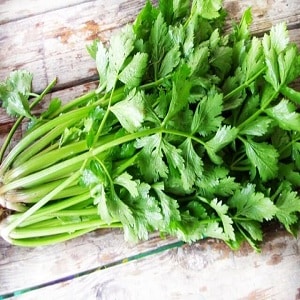
Chemical composition
Celery is rich in vitamins, minerals, easily digestible carbohydrates, vitamins, and aromatic compounds. The chemical composition of petiole and leaf celery is the same. The table shows the vitamin and mineral composition of petioles and greens (per 100 g).
| Name | Content | Norm |
| Vitamin A | 750 mcg | 900 mcg |
| beta carotene | 4.5 mg | 5 mg |
| Vitamin B1 | 0.02 mg | 1.5 mg |
| Vitamin B2 | 0.1 mg | 1.8 mg |
| Vitamin B4 | 6.1 mg | 500 mg |
| Vitamin B5 | 0.246 mg | 5 mg |
| Vitamin B6 | 0.08 mg | 2 mg |
| Vitamin B9 | 21 mcg | 400 mcg |
| Vitamin C | 38 mg | 90 mg |
| Vitamin E | 0.5 mg | 15 mg |
| Vitamin H | 0.65 mcg | 50 mcg |
| Vitamin K | 29.3 mcg | 120 mcg |
| Vitamin PP | 0.5 mg | 20 mg |
| Potassium | 430 mg | 2500 mg |
| Calcium | 72 mg | 1000 mg |
| Silicon | 2.9 mg | 30 mg |
| Magnesium | 50 mg | 400 mg |
| Sodium | 200 mg | 1300 mg |
| Sulfur | 6.9 mg | 1000 mg |
| Phosphorus | 77 mg | 800 mg |
| Chlorine | 26.8 mg | 2300 mg |
| Iron | 1.3 mg | 18 mg |
| Iodine | 7.5 mcg | 150 mcg |
| Cobalt | 0.86 mcg | 10 mcg |
| Manganese | 0.103 mg | 2 mg |
| Copper | 35 mcg | 1000 mcg |
| Molybdenum | 5.4 mcg | 70 mcg |
| Selenium | 0.4 mcg | 55 mcg |
| Fluorine | 4 mcg | 4000 mcg |
| Chromium | 2.1 mcg | 50 mcg |
| Zinc | 0.13 mg | 12 mg |
The table shows the chemical composition of celery root (per 100 g).
| Name | Content | Norm |
| Vitamin A | 3 mcg | 900 mcg |
| Beta carotene | 0.01 mg | 5 mg |
| Vitamin B1 | 0.03 mg | 1.5 mg |
| Vitamin B2 | 0.06 mg | 1.8 mg |
| Vitamin B4 | 9 mg | 500 mg |
| Vitamin B5 | 0.4 mg | 5 mg |
| Vitamin B6 | 0.15 mg | 2 mg |
| Vitamin B9 | 7 mcg | 400 mcg |
| Vitamin C | 8 mg | 90 mg |
| Vitamin E | 0.5 mg | 15 mg |
| Vitamin H | 0.1 mcg | 50 mcg |
| Vitamin K | 41 mcg | 120 mcg |
| Vitamin PP | 1.2 mg | 20 mg |
| Potassium | 393 mg | 2500 mg |
| Calcium | 63 mg | 1000 mg |
| Silicon | 29 mg | 30 mg |
| Magnesium | 33 mg | 400 mg |
| Sodium | 77 mg | 1300 mg |
| Sulfur | 15 mg | 1000 mg |
| Phosphorus | 27 mg | 800 mg |
| Chlorine | 13 mg | 2300 mg |
| Iron | 0.5 mg | 18 mg |
| Iodine | 0.4 mcg | 150 mcg |
| Cobalt | 1.8 mcg | 10 mcg |
| Manganese | 0.158 mg | 2 mg |
| Copper | 70 mcg | 1000 mcg |
| Molybdenum | 4 mcg | 70 mcg |
| Selenium | 0.7 mcg | 55 mcg |
| Fluorine | 4 mcg | 4000 mcg |
| Chromium | 2.4 mcg | 50 mcg |
| Zinc | 0.33 mg | 12 mg |
KBZHU
Nutritional value of celery root per 100 g:
- calorie content - 42 kcal;
- proteins - 1.5 g;
- fats - 0.3 g;
- carbohydrates - 7.4 g.
Nutritional value of petioles per 100 g:
- calorie content - 12 kcal;
- proteins - 0.9 g;
- fats - 0.1 g;
- carbohydrates - 2.1 g.
Nutritional value of the leaf variety:
- calorie content - 13 kcal;
- proteins - 0.8 g;
- fats - 0.1 g;
- carbohydrates - 1.9 g.
Beneficial features
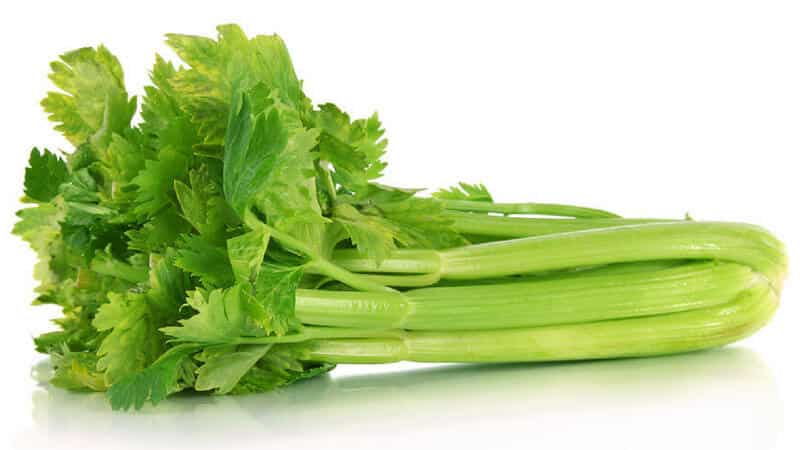
Useful properties of celery:
- relieves inflammation;
- protects cells from the harmful effects of oxidative processes;
- promotes rapid elimination of nicotine;
- supports the immune response;
- breaks down fats;
- enhances libido;
- strengthens the walls of capillaries and blood vessels;
- normalizes blood pressure;
- destroys cholesterol plaques;
- increases hemoglobin;
- reduces allergy symptoms;
- has a mild laxative effect;
- tones the body;
- removes excess liquid;
- prevents the progression of Alzheimer's disease;
- regulates metabolism;
- normalizes the menstrual cycle;
- reduce the unpleasant symptoms of menopause.
- regulates the functioning of the gastrointestinal tract;
- improves intestinal motility.
Benefits for men
Celery has a beneficial effect on men's health. Chereshkovy stimulates the production of the male hormone androsterone, which enhances potency and libido. Regular consumption of the root and leaves normalizes blood pressure and rejuvenates the body, reduces irritability, calms, and improves memory.
Women
Celery is recommended for women to consume to maintain the natural beauty of skin, hair and nails, reduce fat deposits, normalize metabolism and water-salt balance.
The plant has a negative calorie content - the body spends more energy on its processing than it receives. Due to this feature, the leaves, petioles and roots are included in low-calorie diets. Celery juice reduces the vascular network on the legs, reduces the likelihood of developing varicose veins.
Children
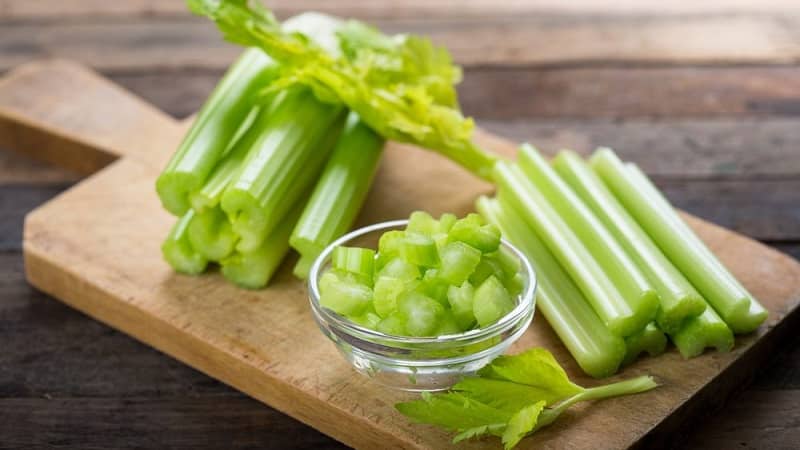
Celery is good for a growing body. Greens, roots and stems are allowed to be introduced into the baby’s diet starting from 7 months. By this time, the digestive system will be ready to digest fiber.
Moderate consumption of the product in childhood:
- promotes rapid regeneration of damaged skin;
- improves digestive function;
- increases iron levels;
- relieves pain;
- removes uric acid salts;
- stimulates appetite;
- has a mild sedative effect.
Norms and rules of consumption
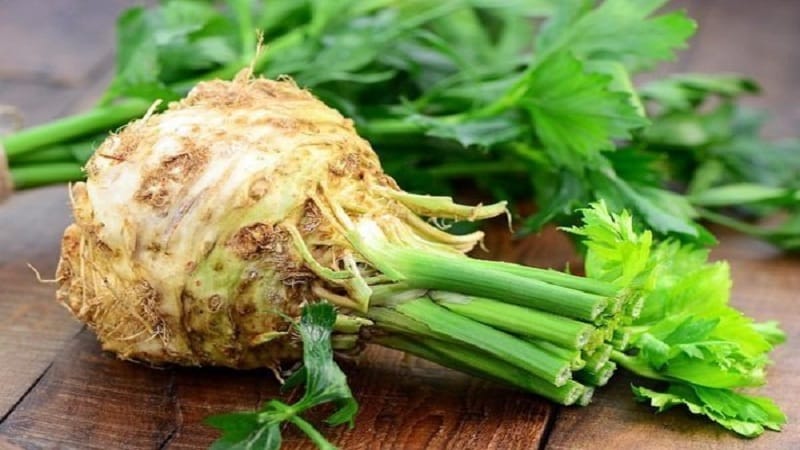
The norm for celery consumption is 300 g per day. The product can be eaten raw, boiled, baked, fried, pickled. Petioles and leaves are added to fresh vegetable and fruit salads. The root goes well with carrots, onions, herbs, and apples.
Before preparing the root, the thin skin is cut off, the pulp is cut into strips or grated. The juice from the root and petioles is drunk freshly prepared.
Cooking recipes
The uses of celery in cooking are varied. Fresh herbs and petioles have a pleasant, refreshing taste that will enrich any dish of vegetables and meat. Dried roots and herbs are added to soups, borscht, broths, sauces, and stews.
Advice. The quality of stem celery is determined by its crunch. Break the petiole into two parts. If you hear a crunch, you have excellent quality celery; if not, put the product back.
Try making an interesting appetizer using squid, ginger root and celery. To do this, prepare the ingredients:
- squid - 1 kg;
- petiole celery - 200 g;
- ginger root - 10 g;
- soy sauce - 3 tbsp. l.;
- wine vinegar - 2 tbsp. l.;
- vodka - 2 tbsp. l.;
- onion - 1 pc.;
- allspice ground pepper - to taste;
- vegetable oil - 2 tbsp. l.
Preparation:
- Peel the squid from the film, remove the chitinous plate and cut into strips. Immerse in boiling water for 1-2 minutes and transfer to a bowl of cold water.
- Cut the petioles into pieces and place in boiling water for 1 minute.
- Peel the onion and cut into small cubes.
- Grate the ginger on a fine grater.
- Heat oil in a frying pan and fry onion and ginger until translucent.
- Add squid and celery to the pan and cook for 2 minutes, stirring.
- Pour in soy sauce, vinegar, vodka, season with ground pepper, stir. Simmer for 2 minutes and serve.
Use in folk medicine
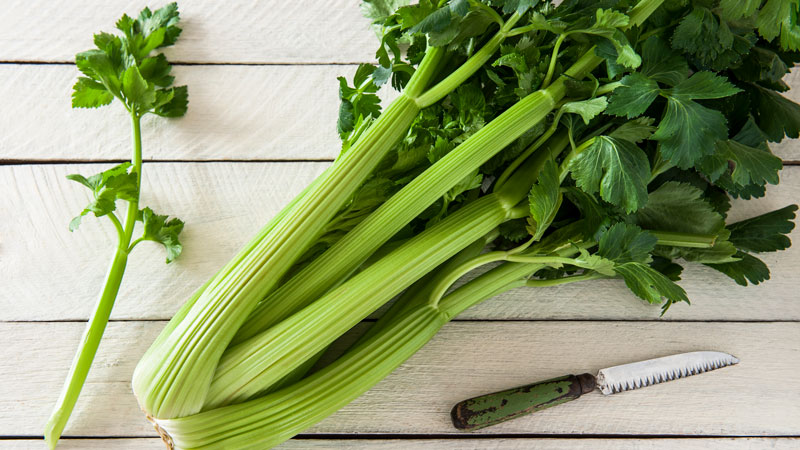
In folk medicine it is often used root. Fresh juice is used to treat gastritis, stomach ulcers, and liver disorders.
The leaf part improves the condition when gout and rheumatism. The leaves and crushed root are poured with boiling water and left for 3 hours in a thermos. Rub the infusion on painful areas and make compresses based on it.
Tea made from dry leaves quickly removes excess fluid from the body, dissolves salt deposits, treats colds, and calms the nerves. For 0.5 liters of boiling water take 2 tbsp. l. raw materials, cook over low heat for 5-7 minutes. Drink 1-2 glasses of tea a day.
Ointment made from leaves and petioles has a healing effect. It is used to treat purulent wounds, rashes, ulcers, urticaria, lichen, and eczema. The raw materials are ground in a meat grinder and mixed with melted butter 1:1. The ointment is applied to the skin and covered with gauze. The product is stored in the refrigerator.
To get rid of allergies and insomnia, the root is grated and poured with water at room temperature (2 tbsp/200 ml). Leave for 3 hours.
To treat gastritis and stomach ulcers, use a decoction: 20 g of crushed root, pour 250 ml of boiling water, boil for 10 minutes, leave for 12 hours in a thermos. The decoction is taken 2 tbsp. l. three times a day.
Freshly squeezed juice from the root and petioles increases potency. It is taken 1-2 tsp. twice a day half an hour before meals.
Contraindications and possible harm
It is not advisable to consume celery during pregnancy due to the risk of uterine contractions. The product can change the taste of breast milk, so it is better to postpone its use during lactation.
People suffering from urolithiasis should not eat greens due to their pronounced diuretic effect. Large stones can enter the ureter and block the passage. In addition, the advancement of stones causes severe pain.
For gastritis with high acidity and gastric ulcers in the acute stage, celery is contraindicated - even in small doses it worsens the condition due to its high fiber content.
Growing and care
Root and petiole celery have a long growth period, so for them growing The seedling method is suitable. Seed material quickly loses its viability and takes a long time to germinate. This means that pre-sowing treatment is indispensable.
The seeds are soaked in warm water for a day, then wrapped in gauze or thin cotton damp cloth and wait for the seedlings to sprout. In a warm environment they appear within a week. Next, the seeds are placed in the refrigerator for 14 days.
Early leaf celery is sown directly into the ground; late varieties have a growing season of 80-100 days, so they are grown through seedlings.
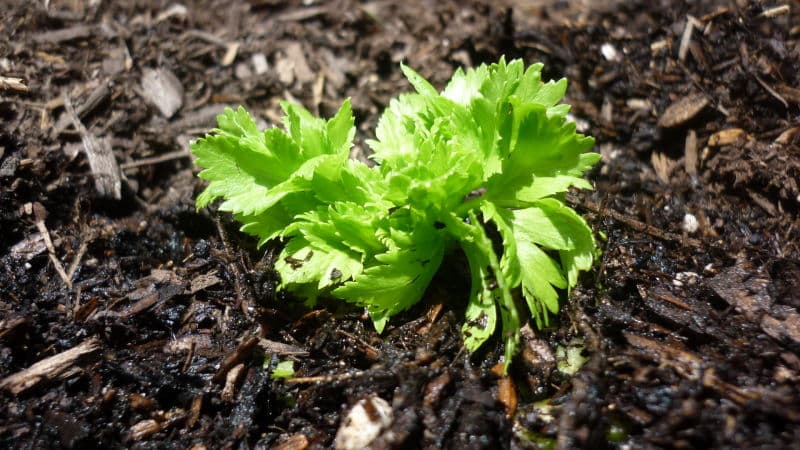
Basic rules for successful cultivation of celery:
- Celery root greens are not cut.Otherwise, not a rounded root crop will be formed, but a “washcloth” of roots.
- High hilling of the root variety is not practiced, so as not to provoke the growth of lateral roots.
- After the root crop appears above the surface, the soil is raked and the root shoots are cleaned to create a rounded shape.
- Celery plantings are watered as the soil dries, without overwatering. Excess moisture provokes the development of putrefactive processes in the root system.
- Root crops are harvested after the tops dry.
- For growing petiole celery, soil with neutral pH=6.8-7 or slightly acidic pH=5.6-6.0 is suitable.
- Stem celery seedlings are planted in areas on the south side of the garden.
- Plantings of petiole celery are regularly thinned. Side shoots are cut off.
- Two weeks before harvest, the stems are wrapped in paper for the purpose of bleaching. This celery has a delicate taste without bitterness.
- Plants are fertilized with potassium and nitrogen fertilizers.
- Sowing of leaf celery seeds is carried out after the soil has been warmed to +10°C.
Varieties
The best varieties of celery root: Albin, Globus, Delicacy, Egor, Esaul, Zvindra, Kaskade, Gribovsky, Maxim, Non Plus Ultra, Snow Globe, Yudinka, Apple.
Popular varieties of leaf celery: Kartuli, Vigor, Zakhar, Tender, Samurai.
Self-bleaching petiole varieties: Tango, Malachite, Golden, Triumph, Pascal.
Petiole varieties that need bleaching: Male Valor, Crunch, Utah, Atlas.
Conclusion
Celery has one peculiarity - it cannot be replaced by anything due to its unique set of vitamins and minerals, recognizable spicy aroma and rich taste.Regular consumption of greens, roots and petioles normalizes the condition of diseases of the genitourinary system and gastrointestinal tract. Fresh juice from the roots and stems reduces the symptoms of varicose veins, rheumatism and gout. All parts of the plant are used in cooking and folk medicine.
The agricultural technology of the crop is simple: regular watering, fertilizing, weeding and loosening the soil, hilling stems, and removing lateral roots from root crops.